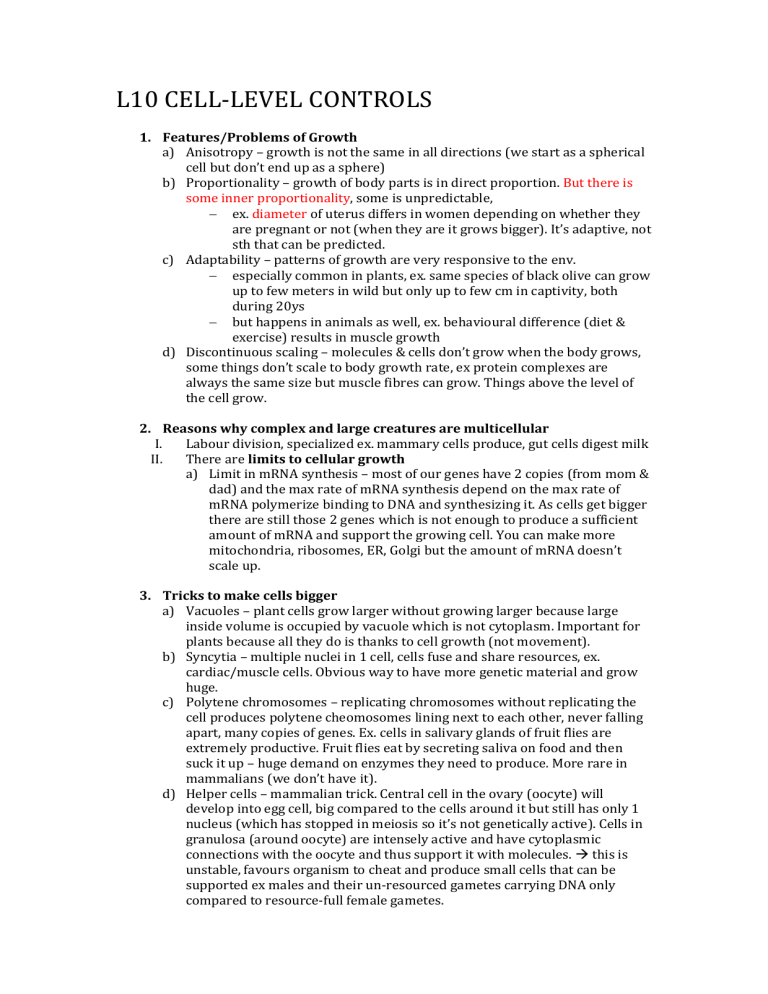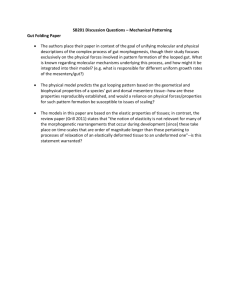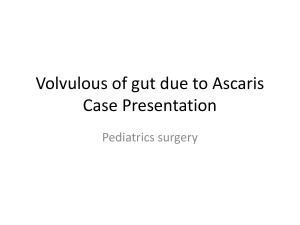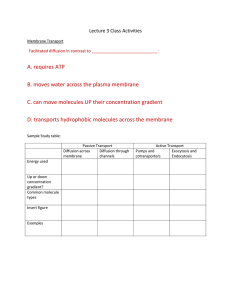Cell-Level Controls: Growth, Division, and Anisotropic Growth
advertisement

L10 CELL-LEVEL CONTROLS 1. Features/Problems of Growth a) Anisotropy – growth is not the same in all directions (we start as a spherical cell but don’t end up as a sphere) b) Proportionality – growth of body parts is in direct proportion. But there is some inner proportionality, some is unpredictable, ex. diameter of uterus differs in women depending on whether they are pregnant or not (when they are it grows bigger). It’s adaptive, not sth that can be predicted. c) Adaptability – patterns of growth are very responsive to the env. especially common in plants, ex. same species of black olive can grow up to few meters in wild but only up to few cm in captivity, both during 20ys but happens in animals as well, ex. behavioural difference (diet & exercise) results in muscle growth d) Discontinuous scaling – molecules & cells don’t grow when the body grows, some things don’t scale to body growth rate, ex protein complexes are always the same size but muscle fibres can grow. Things above the level of the cell grow. 2. Reasons why complex and large creatures are multicellular I. Labour division, specialized ex. mammary cells produce, gut cells digest milk II. There are limits to cellular growth a) Limit in mRNA synthesis – most of our genes have 2 copies (from mom & dad) and the max rate of mRNA synthesis depend on the max rate of mRNA polymerize binding to DNA and synthesizing it. As cells get bigger there are still those 2 genes which is not enough to produce a sufficient amount of mRNA and support the growing cell. You can make more mitochondria, ribosomes, ER, Golgi but the amount of mRNA doesn’t scale up. 3. Tricks to make cells bigger a) Vacuoles – plant cells grow larger without growing larger because large inside volume is occupied by vacuole which is not cytoplasm. Important for plants because all they do is thanks to cell growth (not movement). b) Syncytia – multiple nuclei in 1 cell, cells fuse and share resources, ex. cardiac/muscle cells. Obvious way to have more genetic material and grow huge. c) Polytene chromosomes – replicating chromosomes without replicating the cell produces polytene cheomosomes lining next to each other, never falling apart, many copies of genes. Ex. cells in salivary glands of fruit flies are extremely productive. Fruit flies eat by secreting saliva on food and then suck it up – huge demand on enzymes they need to produce. More rare in mammalians (we don’t have it). d) Helper cells – mammalian trick. Central cell in the ovary (oocyte) will develop into egg cell, big compared to the cells around it but still has only 1 nucleus (which has stopped in meiosis so it’s not genetically active). Cells in granulosa (around oocyte) are intensely active and have cytoplasmic connections with the oocyte and thus support it with molecules. this is unstable, favours organism to cheat and produce small cells that can be supported ex males and their un-resourced gametes carrying DNA only compared to resource-full female gametes. 4. Growth is not solved by producing large cells. Tricks are rare, cells divide – remain small but become more numerous 5. Cell division alternates growth which is driven by cell cycle G1/2 – growth, M – division The only exception: Embryos decouple growth from division. Total volume of the embryo stay the same, cells are getting smaller and smaller during division, No G1/2, just S/M/S/M. Only first few divisions are synchronized but at the end they all end up pretty much the same size This is because embryo is huge and it needs to come back to the size of a normal cell. Also, a good strategy for getting many cells quickly. And helpful for analysing the cell cycle 6. Tim Hunt looked at cleaving sea urchin eggs and analysed its proteins at different times after fertilization, at different stage of cell cycle. He discovered cyclins Proteins specified by maternal mRNA Destroyed after each cleavage division. Their abundance goes up and down, they cycle in cell cycle, there are lots of them, different cyclins come up at different times. He immobilized cyclins on a gel and found out other proteins that interact with it Cyclins interact with and control kinases that work as such only when a specific cyclin is present (cyclin dependent kinasas, cdk) cdk are present all the time, Cyclins are coming up and down – ex. cyclin1 turns on cdk, switches on production of cyclin2 which will destroy cyclin1 (domino effect) Mechanism of work – cyclin activates cdk, cdk phosporelate protein that controls the cell cycle ex enzymes that will do the synthesis etc. 7. Check points – cell cycle cannot run independently (if it does cancer) a) G1/M – DNA damage check point – if DNA damage is detected, cell cannot enter M b) G1/S check point – cell can only progress if it has (the cyclin that drives it to the S phase will only be produced if the cell has): enough resources enough room external signals asking it to divide (shouldn’t do it on its own) no external signals saying ‘do not divide’ 8. Simplified diagram and signalling pathways Path 1: Genes needed for S phase ex. DNA polymerise Rb – protein that stops those genes being synthesised (active state) If Rb is phosphorylated it becomes inactive and cannot stop the synthesis. Rb can be phosphorylated by cdk that give the permission for gene synthesis. Cdk4/6 has to be with cyclin D but even when it’s there, cdk4/6 can be inhibited by low ATP levels (useful check starving cell cannot divide) or by GSK3b enzyme. But growth factors (give permission to divide) can inhibit GSK3b (so it’s inactive, cannot inhibit cell division). Double negative. Path 2: TGFb (don’t divide signal) signals through Smad3/4 to inhibit both Cdk4/6 and Cdk2 (cells cannot divide) p21 is sensitive to DNA damage and Smad3/4 signalling and, if activated, can inhibit Cdk2 and result in no progression if the cell has DNA damage or not enough space Rb stands for retinoblastoma – cancer. In most cells if we delete Rb there are other systems that will stop cell division. But in retinoblast cells that produce retina cells don’t have them. If a person has no working copy of Rb (homozygotes recessive), retinoblasts will divide uncontrollably and result in tumour called retinoblastoma. Warning: real cells pay attention to many growth signals and combine them in very complicated ways. 9. Typical cells make growth factors to signal one another (paracrine signalling). Important to control proportion of their growth. Cells are not self-sufficient – they depend on other cells and their signals. If a cell becomes self-sufficient and starts to produce its own growth factors cancer. This growth factors self-production may be caused by cancer viruses. L11/2 SOURCES OF ANISOTROPIC GROWTH 1. Environment can directly drive morphogenesis Cell’s growth rate depends on nutrients availability – when ex. a bacterial cell colony doesn’t have enough nutrients it will grow in a shape of a fractal. Cells at the edges of the colony will, on average, be fed better and thus they will proliferate. It’s a colony shape, not an organism’s shape but it shows how important is nutrients availability in determining anisotropic growth. Model shape = = real shape of Bacillus subtillis growing on agar = shape of copper electrodeposition in -10V potential well (non-living things do it too!) This simple mechanism can create complex shapes: 2. Directional cell division sets tissue shape Plants’ cells can only grow (vacuoles) and divide in a certain direction. Stereotypical directions of cell division: When divisions’ orientations are right / get confused: a) WT – 1 periclinal division & lots of anticlinal divisions of root cells results in a formation of a double layer of cells. b) MT – genetically determined mistake in divisions orientation: many periclinal divisions & 1 anticlinal division extra layers of cells in Schizoriza mutant 3. The effect of growth in complex tissues (animal cells) a) Mechanical stress orientate expansion: (In the absence of over-riding factors) cells orientate their division planes in the direction that will reduce mechanical stress in tissue: cells added. . . . . . stress . . . . . cells added b) Crowding and cues orientate expansion Human dermal fibroblast cells in tissue culture will: Align randomly if the env is uncrowded Line up with each other (form oriented domains) if it’s crowded Line up with the routes (groves, cues) if there are such 4. How did the gut end up loopy? The gut is connected to the rest of the body via mesentery – thin membrane on which blood vessels lie. Growing chick’s gut develops loops as well Unloopy -------------------------- loopy (those are not spirals) Two experiments: mesentery is important for the gut to make curves I. II. Take mesentery & the gut stretch them let them go they come back to the loopy shape Remove mesentery stretch the gut let it go gut cannot curve Conclusion: if you remove mesentery the gut won’t curve Remove all mesentery in vitro in the egg unlooped gut develops Remove part of the mesentry in vitro in the egg gut partially unlooped Conclusion: mesentery has to be there fist for the loopy gut to develop How did the gut ended loopy? a) We would expect that would be a low proliferation zone, then high proliferation zone, low, high, low, high and which would allow curves to develop (some parts have to grow faster than the others). BUT that’s not what happens b) Instead: Proliferation rate is the same for all gut parts and the same for all mesentery parts There is more proliferation in gut than in mesentery This causes the loops to be formed because gut & mesentery are attached to each other and because gut grows faster than mesentery. When gut tries to grow faster and mesentery doesn’t let it do so, gut forces curves and loops are created Similar mechanisms: Cu expands more than Fe so the rails bend combine flexible plastic tube with a rubber that was stretch so it has the same length as the plastic, then saw both and let the rubber go rubber goes back to the original length & creates curves/loops 5. (remember point 2?) Tissue shape is determined not only by the direction of growth but also by cell polarity on cell sheets. Apico-basal polarity of epithelial cells (up&down) 3D polarity Planar cell polarity – polarity within the plane of the membrane/epithelial sheet How to achieve the sense of polarity? Fmi are receptors. Fz from A binds Stbm on B Pk inhibits Dsh Fz cannot be recruited Fz is recruited on the other side of B where Dsh is not inhibited. The same happens with C – Stbm on the left and Dsn on the right. So if 1 cell has polarity all other cells will copy it polarity is superimposed & passed on in a tissue In mitosis: First, tubules are located randomly in a cell If there are localized cortical MT binding proteins, tubules will get trapped in 1 direction/plane & in this direction cell division will happen & in this direction tissue will grow cell polarity signal (MT binding proteins orientation) transferred to mechanical action (cell division) tubules are locked in both epithelium plane (planar cell polarity) & horizontal plane so division happens in the plane of epithelium & in the direction that proteins pulls the spindle (horizontal not vertical) 6. Neurulation refers to the folding process in vertebrate embryos, which includes the transformation of the neural plate into the neural tube *We are 2 tubes (gut & neural tube) within a tube. Neural tube (spinal cord) forms when the valley of epithelium sheet dips down cells come together bind tube gets separated from the skin (the rest of epithelium cells) Orientated mitosis and plane of cell polarity orients cell division in this direction. If neurulation goes wrong: spina bifida - incomplete closing of the backbone and membranes around the spinal cord anencephaly – rostal end of neural tube fails to close absence of a major portion of the brain, skull, and scalp. L12/3 BODY SIZE AND BODY SHAPE 1. How is one body part able to be very different in size in genetically similar animals? (males have anthers, females don’t) Environment influences the size: a) in plants some plants (ex Wisteria) have no size limits, they grow until something kills/restricts them that’s why the same plant, same age, when grown in captivity is significantly smaller than in wild b) in animals nutrition & diseases affect overall growth (ex humans over years) Foetal transfusion syndrome (good ex of how important env is even when genes are the same) Identical twins develop when inner cell mass separates Those twins share placenta Usually that’s fine but because blood vessels grow in a random way across placenta, sometimes 1 twin may end up steeling from the other (most of the nutrients/gases go to 1 twin) 2 genetically identical babies but 1 smaller than the other (the catch up will never be complete) Animals have a maximum size for a species (ex all 3 human races have the same max height) while plants/fungi not always. Genes control the size: Ex. humans control genetics, and this size of dos’ species Sex determines the size: Sexual dimorphism – females are usually larger than males Same growth genes but different chromosome sets – males could grow up to the same size because it has the same growth genes for some reason it doesn’t In humans: mammary glands size, clitoris/penis, height In deep sea fish – hard to find a mate so male grows as a parasite inside the female when they meet each other 2. How do fully-grown organisms tend to respect a characteristic size? 2 forms of body shape: a) Vitruvian Man shape – relative proportions of human body parts, normal/average proportions externally and internally b) Non-Vitruvian Man shape Pituitary gland controls growth: It secretes growth hormone (GH) which drives growth GH signals to local tissues that make 2 other molecules: IGF1 & IGF2 – insulin-like GF but they’ve nothing to do with nutrition Pituitary tumours are associated with gigantism more GH produced. The same happens when mice are genetically modified and produce too much GH (they are bigger but proportional) Mutant GH receptor insensitivity to GH Laron syndrome still Vitruvian but small (proportional growth & growth at all happens because those ppl aren’t the size of a fertilized egg) GH isn’t the only factor controlling the size GH affects post-natal muscle growth directly but other tissues only indirectly. Mutations in IGF1&IGF2 homozygotes dominant ok, heterozygotes smaller, homozygotes recessive (double knock out mice) tiny 3. How do body parts grow to the right size for each other? Why both legs are the same size? How do they know how long to grow? Rabbit leg experiment: Restrict blood supply to 1 leg reduced nutrients supply growth of 1 leg inhibited/reduced but the contralateral leg grows normally Conclusion: legs are not dependent on each other (they don’t communicate with each other, don’t catch up 1 after the other) Release the inhibition when the rabbit is still young inhibited leg caught up before the animal had stopped growing (it was growing faster) Conclusion: growth rate is not set, 1st leg was slowing down (it was already the right size) and there was enough GH for the other leg to grow faster (without inhibiting the growth of the unrestricted leg), same cp of GH but different growth rate leg knows how big it must get and it aims at that size and then it stops Possible explanation: The ability of the bone to respond to GH declines with the number of cell divisions Cells count cell divisions and stop dividing when enough of them occurred Real explanation: Growing bone has a growth plate – this is where the bone is formed On the edges – periosteum Growth plate: Zone of proliferation full of stem cells. ST produce new cells, cells enlarge & differentiate to become cartilage producing cells. Cartilage producing cells produce cartilage. Within the cartilage cells die and get replaced be the cells that are coming up from the already existing bone. Proliferation moves the cells upwards/ cartilage cells dying are replaced by bone cells bone grows The rate of this happening is controlled by various signals: GH IGF1 from the liver controls proliferation in the SCs zone Cartilage producing cells that are dying send CNP signal to the young cartilage producing cells to replace them Young cartilage cells then signal to SC to keep on producing more cartilage cells so the young ones can replace cartilage-producing cells. This signal is nor local nor direct. Indian Hedgehog signal goes to periosteum (sheath of bone) from there another peptide hormone is produced called PTHrP signals SC to proliferate When the bone is small this loop is efficient – small distance to travel. When the bone grows the distance increases and the signal becomes less efficient promoting less growth at some point it’s so inefficient the bone doesn’t grow anymore! So even though GH cp is the same, when one leg is smaller it will respond to the signal while the big bone in the other leg won’t Non-vitruvian genetic condition/mutation Toulouse-Lautrec syndrome/Pycnodystosis: Normal size of trunk and head but short limbs. Mutant for the Cathepsin K (enzyme) Mechanism of limbs growth: IGF comes from the liver to the growth plate It binds to high affinity IGF receptors but also to the low affinity IGF receptors (they don’t signal, just hold IGF) Cathepsin K cuts the bond and liberates IGF from low affinity IGF receptors so it can bind to high affinity IGF receptors, signal and drive growth. Without Cathepsin K IGF is stuck there and the growth plate thinks there is less IGF then there really is – limbs grow slowly Only limbs use the mechanisms involving cathepsin K and that’s why only they are affected CONCLUSION from 2&3 Body and head carry on growing anyway – body proportions are not set by communication btw body parts, body parts don’t relay on each other. Thus, evolutionary changes in ex limb length can occur without changing the rest of the body. The amount of soft tissue (skin, tendons, muscles) is still correct for the shortened limb (there is no excess skin on a shorter limb!) – bones are directly affected by the global growth signals but soft tissue is not, it responds to the bones size hierarchy of control L13/4 KEEPING DIFFERENT TISSUE COMPONENTS IN PROPORTION 1. Why is the amount of skin always right for the leg length? … or any other growth How does the skin know what volume to cover? Body size in unpredictable Not genetic Changes during life time (gaining weight, pregnancy) Mechanical forces (excessive stretch) to skin (ex. body modifications) drives skin growth automatic adaptation Experiment: How mechanical stress promotes growth: grow cells on square island (gold around, cells don’t grow there) stress is concentrated at corners more proliferation at the corners the same happens when bone is growing tension proliferation also: Experiment: How ‘mechanically isolated’ organs grow? (most internal organs are not attached) remove spleen from a mouse (it will still survive without it) insert lots of foetal mouse spleens total mass of the grown spleens = mass of 1 normal spleen probably spleen cells secrete sth (x) into the circulation which is diluted in the body and then sense how much x is coming back from the circulation. If its not much (diluted, body must be big) – they carry on growing, if there is enough – they stop. That’s how the sense how big the body is. but if you do the exp with thymus, each grows normal size so it can’t be that simple Quorum sensing Cells aggregate quorum sensing (there must be enough members) start forming sth (skin, nephron, thymus). How do they know that there’s enough of them to start the work? Quorum sensing: Autocrine sensing cells coming together secrete a factor (x) and sense it via receptors for x if the cell is on its own the signal will dilute & it will detect a small amount if there are lots of cells more signal is coming back that’s how cells measure the amount of cells around them there is a threshold that allows them to respond to the signal & work (differentiate) non-indecisive decision making: Quorum sensing: growth (via proliferation or recruitment) x is building up threshold response Experiment: evidence of quorum sensing in the kidney Tree of tubes that will create a collecting duct grows Mesenchymal cells around it detect signals from the tube and at some point decide to become epithelial cells forming the collecting duct/ nephron tube Mesenchymal cells aggregation knot creation if its big enough switch to become early epithelium nephron tube Wnt4 is expressed where the cells aggregate Wnt4-/- aggregates keep growing threshold never reached because there is no Wnt4 no response Drugs where Li+ is pharmacologically active limit Wnt4 pathway (double (-) pathway: Wnt4 signalling inhibits an enzyme that inhibits its gene expression, Li+ also inhibits the enzyme). Li+ mimics Wnt4 signalling even in the absence of Wnt4 small aggregates threshold reached earlier because cell were fooled, thought that the aggregate is big less epithelium formed (no nephrons, too small aggregates) Wnt4-/- is not a knock-out, Wnt4 gene replaced by bacterial gene Gal4 (reporter) so Gal4/Wnt4- cells will generate a detectable Gal4 signal whenever Wnt4 is produced no effective Wnt4 signalling but Wnt4 gene expression low in the aggregates (still some Gal4) positive feedback – the amount of Wnt4 that is made depends on Wnt4 signal (the more Wnt4 the stronger its expression) non-linear relationship btw response and signalling The trophic theory – is one part of the body (nervous system) enough to serve the other (limb)? Experiments: innervation of chick limbs How it is that there is always enough motor neurones and sensory neurones in spinal cord to run the limb? In adult chick there are lots of neurones along the spinal cord lot of them die less death in the regions that will serve the limb Remove one of the limb buds from the embryo when it starts growing by the end of development: on the normal side normal # of neurones going out, on the side where 1 limb bud was remove less neurones Move the limb bud from one embryo to the other so there are 2 limb buds on one side (3 wings) Huge # of neurones on that side (2x than normal) # of neurons match the # of target that has to be served Explanation in neuronal development: when the chick embryo develops there is a lot of mitosis in the spinal cord to get max # cell &THEN elective cell death Mitosis phase is always the same (far too many neurones are produced whatever the target is). Elective cell death changes according to how much target there Neurotrophins (ex. Nerve Growth Factor NGF) – survival factors for neurones that come from the target (ex. muscles in the limb bud) huge target = lots of neurotrophins high survival no target = no neurotrophins huge death lots of them. Targe (ex. muscle) produces neurotrophins for which neurons compete. If there is enough of neurotrophins more neurons will survive innervation matches the target It’s not just a neuronal story (but discovered in neurones): All cells have a constitutive death wish (left on their own they will die) Almost every cell type need to have survival signals from other cell type no cell is an island 1 cell type cannot overgrow the other, it will start to die if it tries to (except for cancer cells) This occurs within 1 tissue and between tissues (nervous system limbs). It’s always the absence of death that matters, not the proliferation rate. Not all of the supporting material is on learn (check out the other website). Book: Mechanismsm of morphogenesis by J. Davies.




